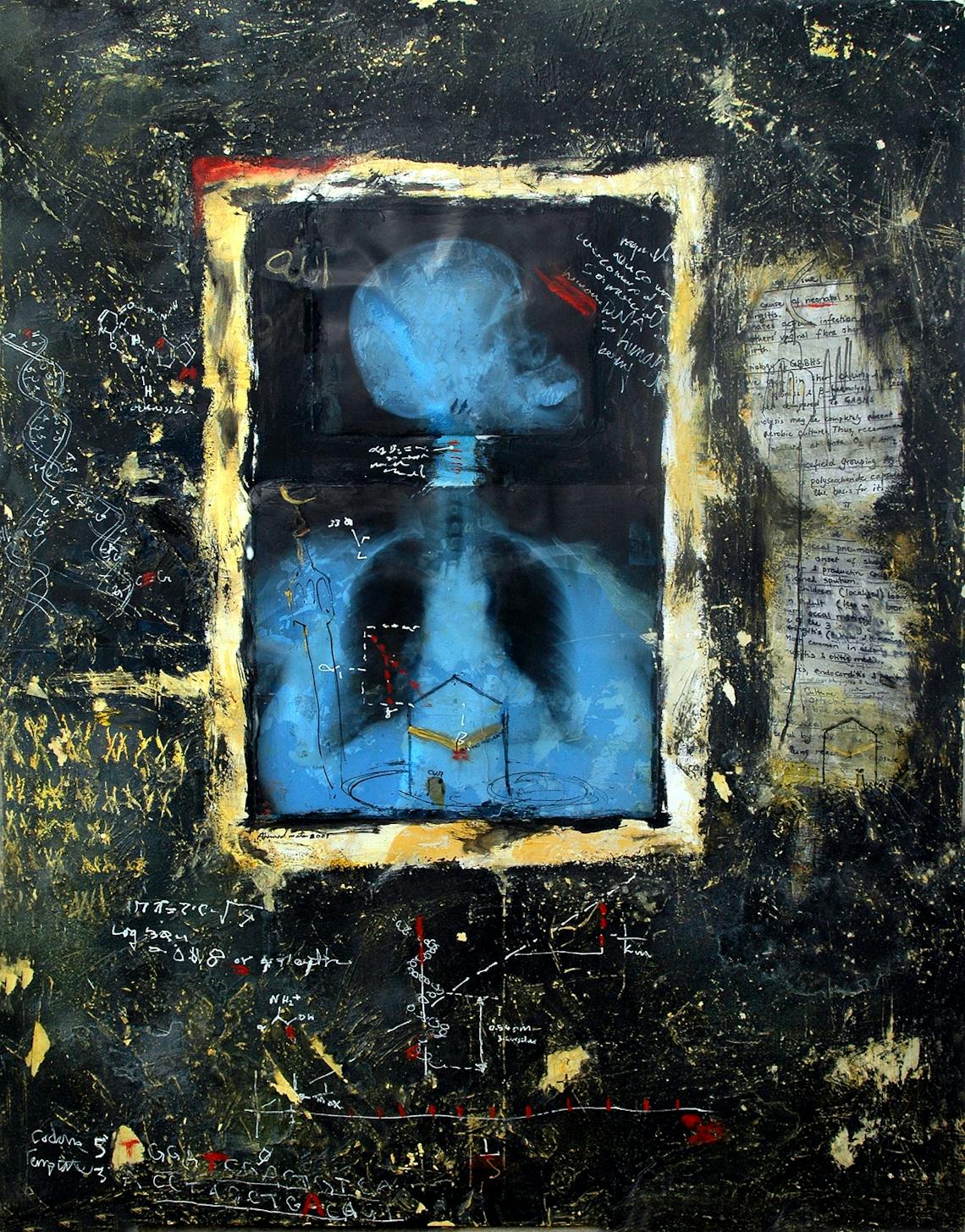
X Ray III
It started with X-Ray. I was immediately drawn to the skeleton at the centre of the canvas fascinated by the complexity of this remarkable painting, and in museum curator mode attempted to decode it.
The Holy Ka’ba, the focus of Muslim belief at the heart, a half-circle denoting the tawwaf, or circumambulation that takes place during Hajj, a minaret, the word Allah. Fragments from medical textbooks, and a multiplicity of complex signs and symbols surrounding the central window. I tried to draw out the meanings from Ahmed and he explained the work as follows: ‘this painting explores the confusion in the identity of mankind in the contemporary world. The X-ray, sitting on top of a deep, layered background of medical text and expressive paint, represents an objective view of the individual, chosen to provoke a familiar response…My approach as a doctor has been evidence-based and influenced by a direct experience of the world’ (Word into Art 2006: 95-6). But the words remained as complex and mysterious as the work. Ahmed was drawing deeply on his own beliefs and culture and Basquiat and much else besides and this work remained beautiful and elusive.
The skeleton turned into the series Illuminations: still in X-Ray form, this ghostly shape is placed at different angles sometimes looking straight on, sometimes turned to one side or another. Ahmed was now finding inspiration from the arts of the book in Islam and Qur’anic illumination in particular, and turning it into the frame for the X-Ray. The sources are recognizable and are characteristic elements of Islamic art: geometric designs, panels of elaborate arabesques and the roundels which traditionally mark sections of the Qur’an, or which tell you when to make a prostration; these elements are typical in style of Qur’ans made for the Mamluk rulers of Egypt and Syria in the late medieval period. But although evoking the manuscript tradition, this is not pastiche. These paintings at over one metre high, are bold and strong, and are making their own statement and create an intimate relationship between the work and the viewer. In Talisman Illumination I, the border takes us into another direction; for in this work Ahmed has turned to the powerful tradition of amulets and protection in Islam. He is inspired by the talismanic shirts made to be worn under armour in battle and popular in many parts of the Islamic world – some of the grandest to be found in Topkapi palace in Istanbul. They are covered with what are known as magical squares and groups of single Arabic letters. These elements along with other signs and symbols belong within the ancient vocabulary of magic where letters and numbers have particular meaning and protective powers. The elaborate squares often make up the names of God and are therefore a sign of ultimate protection. This is good magic and with powerful resonance still today.
As Ahmed developed the theme the works increase in subtlety: they can contain fragments of Qur’anic text: Cardiac Illumination II includes two lines in muhaqqaq script from Sura 33 (Ahzab) verses 22-23 [‘they would wish they were in the deserts and wandering among the Beduin and] seeking news about you from a safe distance and if they were in your midst, they would fight but a little’. Surah Illumination I has, in tiny script a verse from Sura 104 verse 5 (al-Nas) seeking refuge from ‘the one who whispers into the hearts of mankind’. Mashq X-Ray I is further abstracted: the skeleton is at last integrated into the painting; text covers the head like the calligraphic exercises known as mashq; groups of letters are pressed in from the back.
Two of the series illustrated here, Illumination I & II, were shown in Edge of Arabia and it is worth repeating the catalogue text which was based on Henry Hemming’s interview where Ahmed explains what lay behind the series, and the technique he employs to create those works: ‘They are laid out in exactly the same way as the beginning of a religious text. I have also added the word waqf beneath each. This means charity. Traditionally in religious texts you have two pages, symmetrical in design, containing abstract design. The craftsmen would always spend a great deal of time on these opening pages: they’re the first thing you see. Instead of a traditional geometry I have printed two facing X-ray images of human torsos. I prepared the paper using tea, pomegranate, coffee and other materials traditionally used on these kinds of pages. By using them you ensure that when you come to paint onto the paper it will have an extraordinary luminous quality – the paint will truly shine. And that’ what I want to do with this piece, to illuminate. I am giving light. It’s about two humans in conversation. Us and them, and how this encounter gives light. Dar a luz. So many religions around the world share this concept of giving light, not darkness. It is one religious idea that has reached mankind through many different windows.’ (Edge of Arabia p.33)
These are powerful and multi-layered works which, while touching on aspects of Islamic art tradition, go beyond it with remarkable freshness and originality. For the British Museum which acquires modern and contemporary Middle Eastern art, and which owns two of the paintings included here, Ahmed’s work is a strong expression of the dynamic cultural complexity that is visible in the art of this region.
Venetia Porter
British Museum
London, UK
February 2010
References:
Hemming H, Porter V. 2008 Edge of Arabia, Contemporary Art from Saudi Arabia, London
Porter V. 2006 Word into Art: Artists of the Modern Middle East, London